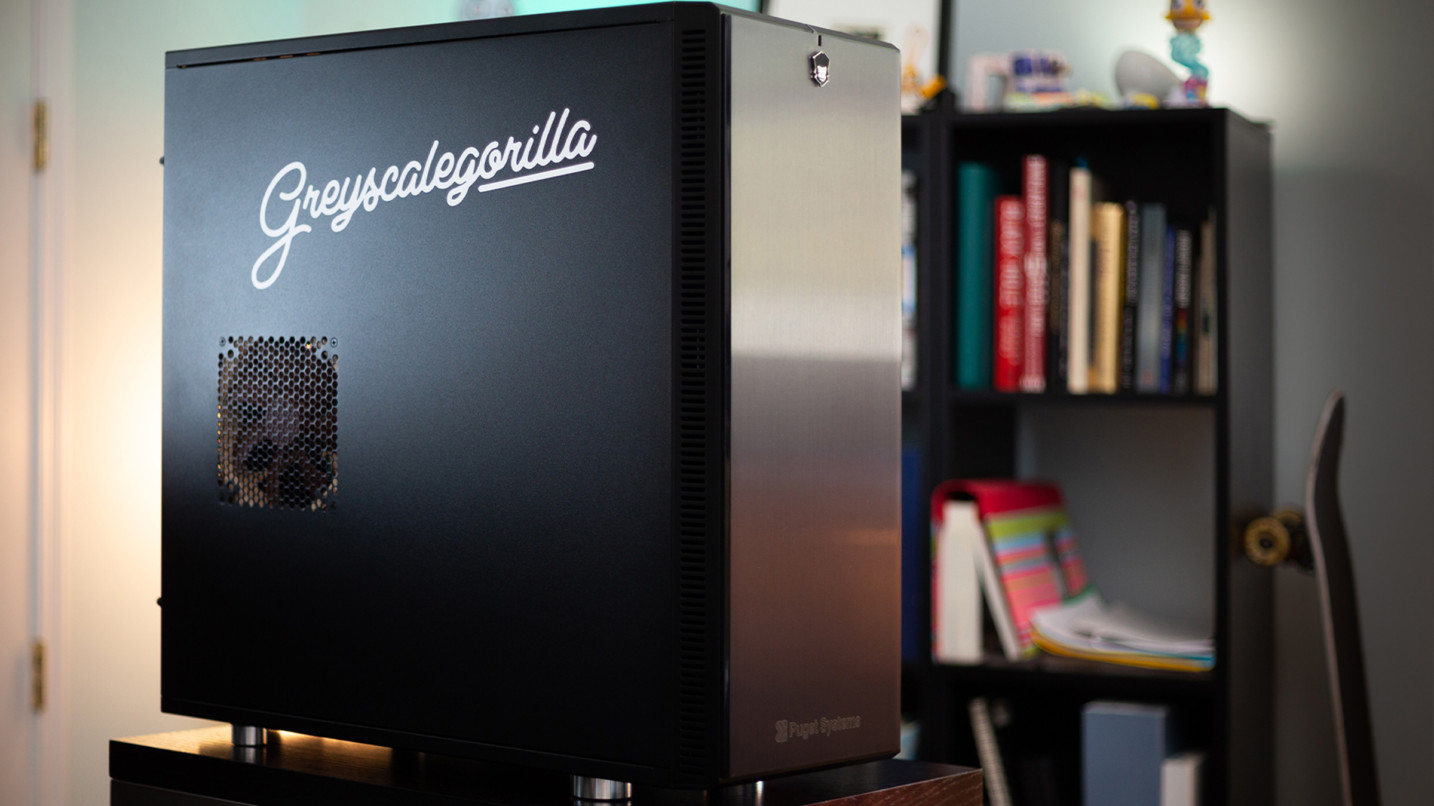
We heart Puget.
After a few years of various frustrating hardware issues, Nick and I decided it was time for a PC upgrade. Between failed liquid coolers, loud fans, and dead hard drives, we’d had it with systems that were designed more for gaming than GPU rendering. We wanted our next systems to be ready for work, and we needed a hardware partner that understands 3D/Motion Design… In walks Puget Systems.
We considered building our own systems for a brief moment, but after COVID decimated supply chains, the thought of trying to source parts made us decide against it. With only some of the team being PC savvy enough to handle issues independently, we also needed top-level support.
Looking for specs and benchmarks? Scroll to the bottom!
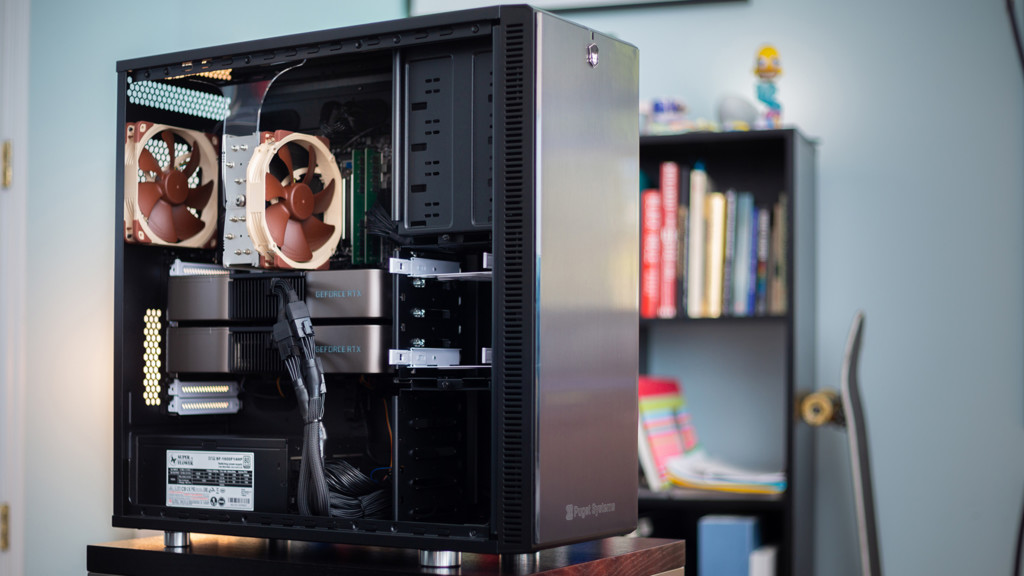
Heard good things
I had been hearing great things about Puget Systems of Auburn, Washington, for some time. Their blog is filled with research posts where they frequently dive deep into the hardware and how it relates to our industry. It seemed that every Puget customer I talked to was singing their praises. They had built a solid reputation based on excellent build quality, thorough testing, and top-level support. So we pulled the trigger.
The entire experience was unlike any I’ve had when buying a PC. I called them up on the phone and told them what sort of work I’d be doing and what kind of renderers I’d be using. And the whole time, the person on the phone knew EXACTLY what I was talking about. It was a totally refreshing experience. After a short while, we landed on a spec list that would work for both CPU and GPU rendering (#cpunotdead).
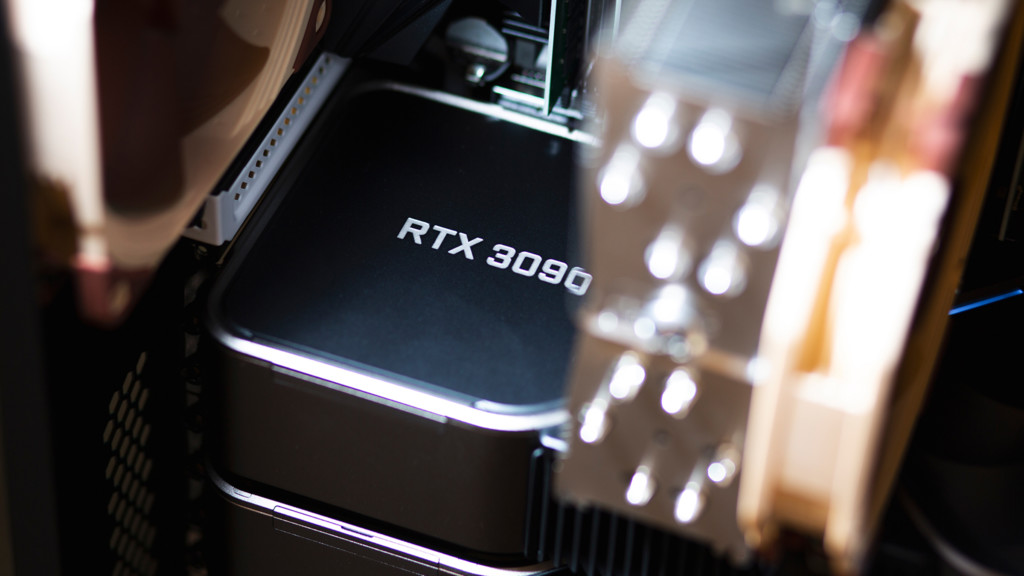
I mentioned thermals and system volume as some of my biggest concerns (since my office is on the top floor and gets quite hot when I’m rendering). My computer is also next to my desk, so I needed something relatively quiet. The salesperson went into detail about how serious Puget takes testing and specifically thermals. They rigorously benchmark your system and even take thermal images under full load. I was immediately impressed.
In the end, Puget recommended their Fractal Design Define XL R2 case and suggested I went with a Noctua NH-U14S TR4-SP3 CPU fan instead of a closed circuit liquid cooled option. They explained that “it’s not a matter of IF a liquid cooler fails, it’s a matter of WHEN”. That was an easy sell for me since both Nick and I had to replace our Enermax coolers. If I never have to replace another one, it will be too soon.
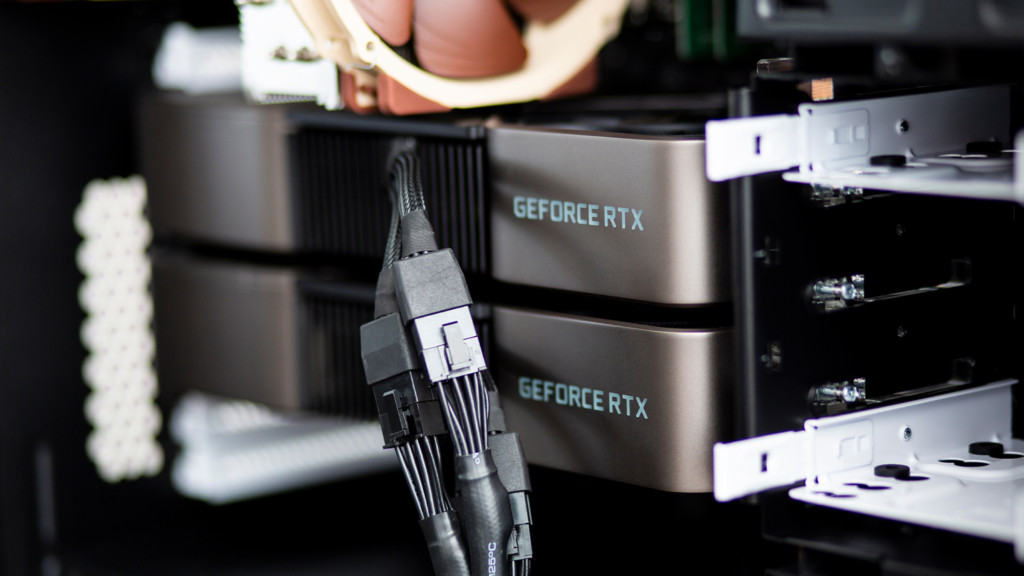
3090s? No Problem
I was also concerned that our wait time to get two systems with dual 3090’s would be insane, but they assured me that it wouldn’t be too much of an issue. They’d even give us founder’s edition cards, which was terrific because I’ve always thought those were the coolest looking ones available (silly, I know).
So with the spec sheet done, the order was made, and we immediately got a personal confirmation email thanking us for the order. It felt good to get a system from a company that specializes in 3D workstations for change.
Not too long after the order was sent, my machine was delivered. It came in a branded box weighing in at just under 80lbs. I immediately opened the box and was greeted with a white three-ring binder labeled “Information Booklet”, complete with a photo of my system on the cover. Inside was a treasure trove of information—everything from a welcome letter to a detailed list of everyone on my system’s team. Super impressive.
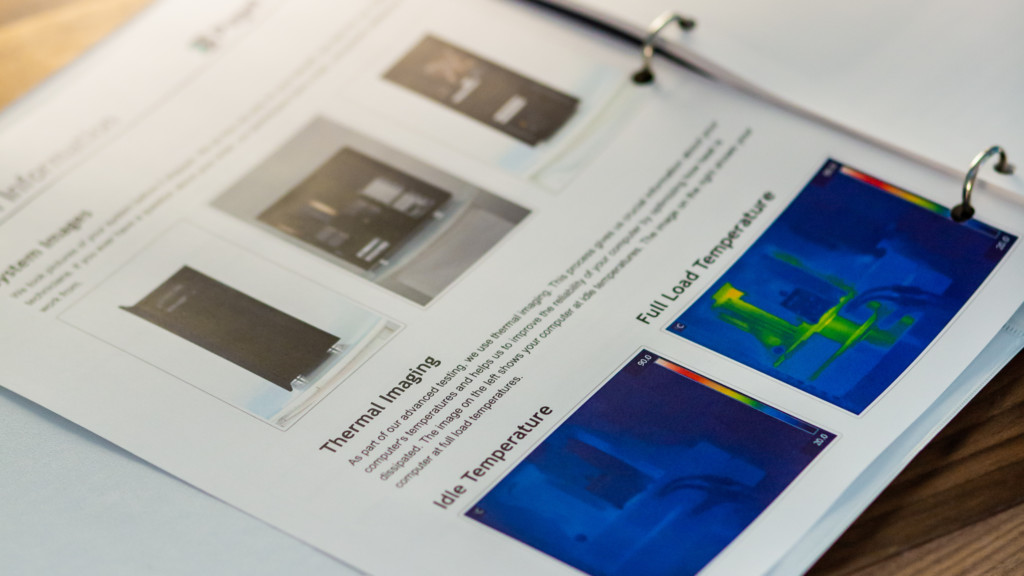
The Extra Mile.
They also included printed benchmark results from all the major tests, as well as frigging thermal images of this system. Let that sink in. They tested THIS COMPUTER, ran a crapload of benchmarks, took thermal images, then packed it all up, printed the results, and sent it to me. Insane!
Soon after setting up the machine (that I lovingly named “Onyx” after the old 90’s supercomputers that used to run Flames), I realized I hadn’t told Puget that I needed an internal M.2 SSD media drive. Whoops. I quickly reached out to Puget and they immediately put me in touch with Chad Warmenhoven in tech support.
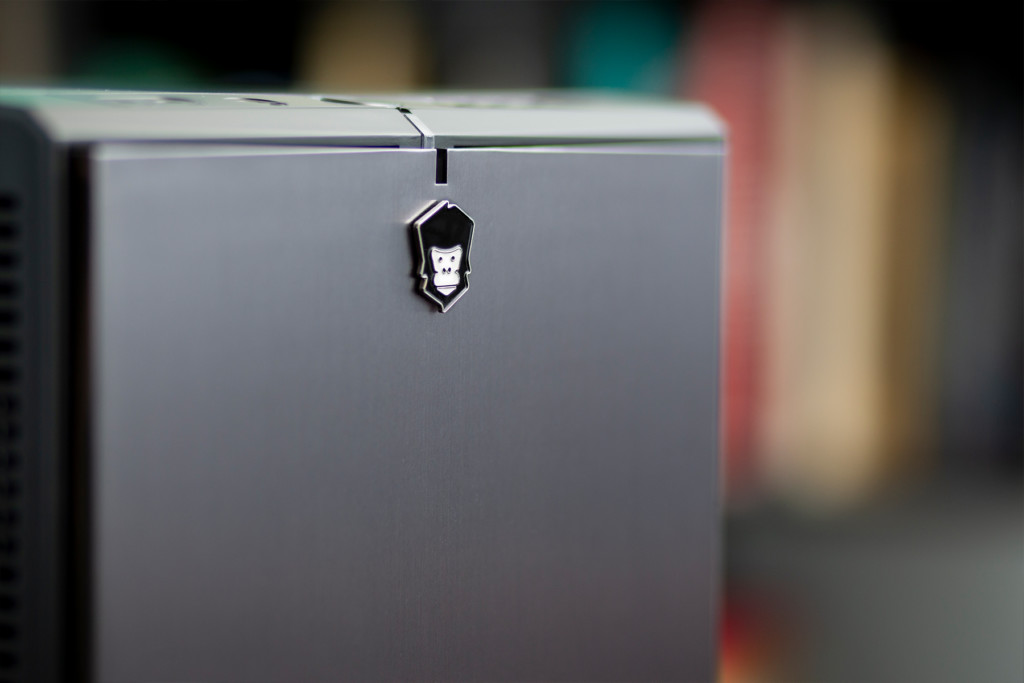
Chad went above and beyond, sending me detailed step-by-step instructions for removing the dual 3090s (they ship with an acrylic custom brace plate). He even went as far as to include photos of my system they had on file and circled areas that would require removal. The process was painless and a day or so later, Chad checked in with me to make sure everything went ok.
In Summary
So here we are now absolutely loving these Puget Systems machines. They are ridiculously fast. Arnold, Octane, and Redshift scream on the dual 3090s. Not to mention, this Threadripper has been amazing with Black Magic Fusion. I’m so glad we went with Puget Systems, and by the looks of it, we’ll be going back to them for the foreseeable future.
You can check out Puget Systems here.
In case you were wondering, the price of this system was around $13,000 but typical Puget workstations average around $8,000.
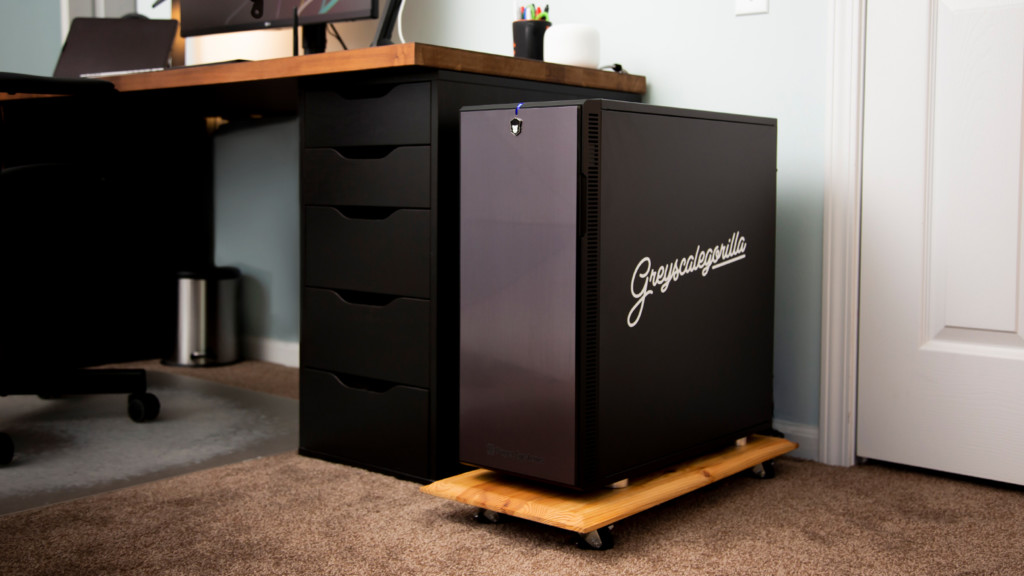
Our System Specs
- System:
- Gigabyte TRX40 AORUS PRO WIFI (Rev. 1.1) Motherboard
- AMD Ryzen Threadripper 3990X 2.9GHz 64 Core 280W CPU
- 128GB (4 x Crucial DDR4-3200 32GB) RAM
- 2 x NVIDIA GeForce RTX 3090 24GB Founders Edition GPUs
- Super Flower LEADEX Platinum 1600W Power Supply
- Storage:
- Samsung 980 Pro 2TB en4 M.2 SSD (System Drive)
- WD Black 4TB M.2 SSD (Media Drive)
- Samsung 980 Pro 1TB M.2 SSD (Media Drive)
- Cooling:
- Noctua NH-U14S TR4-SP3 CPU Cooler
- 3 x Noctua 140mm NF-A14 PWM Case Fans
- Case/Mods:
- Fractal Design Define XL R2 Titanium Grey
- Metal Case Feet
- Greyscalegorilla Vinyl Stickers
- Gorilla Head Enamel Pin
Our System Benchmarks
- Cinebench R23.200: 60330pts
- Cinebench R20.060: 23684pts
- Octane Bench 2020.1.5: 1410.52
- Redshift Bench 3.0.33 (2020.11) Age of Vulture Scene: 85 Seconds
21 Comments
BEST PC SETUP 2023 – Does anyone have any recommendations on PC system for running C4D and Octane? I am finally making the jump :-/ I have been told that at least 196 gig of RAM, 30x cores, as many GPUs as possible, 3x SSD cards at 2tb. I have a budget of up to £8k, and I want to not only be able to render fast, but more importantly I want a very fast and reliable live view, be able to view accurate dynamics movement in the working panel, and unlike my macbook pro and Radion Red Devil RX 6900 XT GPU, I don’t want it crashing 5 times every time I use it. I only tend to need 2meg still renders for packaging design or some mid resolution dynamics MPV files. All thoughts welcome.
Paid about the same for my simular system but it is water cooled
I’m on my second computer, built by Puget Systems. It is an amazing company that understands the needs of creative professionals. Support is fantastic, and they go the extra mile to ensure that you’re getting the best value for your money. If you’re looking for a serious Windows or Linux-based workstation, these folks deserve a close look.
I too went with a Puget system last November. My system is almost identical except I have duel Founders 3080’s and a Thredripper 3970X. I would have done 3090’s but at the time they were concerned about cooling but it’s good to see they resolved that. 7 months with it and I couldn’t be happier. Great people, solid company and tech support that’s always available. Build time was about 3 weeks from the time I ordered to the time I received it. I’m running 2 Noctua 140 fans. Under full load the GPUs still stay cool, those fans may as well power a jet plane. The Fractal Design 7 case allows for tons of ventilation via removing the top plate as well as just opening the front cover.
Congrats! Great breakdown. I just got a Puget system (Same but 32 core TR and only 1 3090😒)… Enough for me as I am still learning. Feck Yeah!
Yes Now I totally agree that is a beast – but unfortunately it runs windows with it’s mish mash of 32bit/64bit horrible mess of a UI, with Multiple design schemas, doubled up control panels, Unintelligible errors and DLLs and components from 1995.
So I bought a Mac Pro with Vega Pros for a bout the same money and I’ll take the 30% less OB score – cos all my actual renders go to a render farm anyway… if only for the system wide Keyboard shortcuts and my stupidly nice XDR monitor.
In Colombia it is a lot of money, with that money I buy a house here. it’s a dream come true that machine beauty the golden dream of every 3d artist congratulations
I spent with my computer has 8,000 €
machine workshop with the computer was https://www.prodimex.ch/
hug to everyone
my computer is turtle
– Installed Ram: 128 GB
– Processor: Intel core i9-9900x CPU 3.50GHz
– 2x Graphics cards: Nvidia Geforce RTX 2080 Ti
Did Puget recommend the Ryzen 2.9GHz processor? Given that all the rendering work is being done by the RTX 3090’s with Redshift and Octane, I would have thought that a faster CPU with less cores would have been the better trade-off as cores don’t matter to GPU rendering – just a fast CPU with a full compliment of PCIe lanes to the graphic cards.
I would love to hear more as to why you picked that combination of CPU, GPU and the motherboard (PCIe lanes in particular).
I’d like to know as well.
I can also add that I ran into some limits when originally looking to go Ryzen that eventually pushed me into a Threadripper. Puget can help figure out what’s best for you, but in my case I couldn’t get all 3 M.2 slots to work on the boards they offered for Ryzen. There were all these weird catches where one slot would be disabled if you used another one. Once you start maxing slots out and tons of memory, you run into limitations on Ryzen.
He did mention Arnold, which runs on the cpu, I think…
We still use CPU for many tasks including rendering. Arnold in GPU mode uses many CPU cores at the same time for other tasks. Also the Threadripper 3990X Turbo boosts to 4.3ghz for single threaded operations.